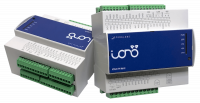IonoPiMax
Iono Pi Max is an extremely versatile industrial server with a huge variety of Input/Output lines and standard communication interfaces, all routed to the incredibly powerful quad-core processor of the Raspberry Pi.
This driver provides support for a local installation of HSYCO on Iono Pi Max itself. The Raspberry Pi OS Kernel module for Iono Pi Max must be installed. The kernel module documentation is available at GitHub and the Iono Pi Max User Guide.
Contents
HSYCO Configuration
Add a IONO Pi Max I/O Server in the I/O Servers section of the Settings and set its parameters:
High Availability
- Shutdown when inactive: defaults to false.
Options
| ID | Default | Values | Description |
|---|---|---|---|
| startupevents | false | true | generate IO events also during the driver’s start-up phase |
| false | start generating events only after HSYCO is aligned with the current status of the system | ||
| pollinterval | 250 | 10 <= n <= 30000 | the data acquisition interval, in milliseconds |
Datapoints
The Iono Pi Max implements all data points provided by the underlying Iono Pi Max kernel module. Refer to the documentation is available at GitHub.
Each readable file name exposed by the kernel module under the /sys/class/ionopimax/ sub-directories appears as a data point with id <subdir>.<file>. For example, as the buzzer's status file is /sys/class/ionopimax/buzzer/status, the corresponding data point is "buzzer.status".
Command files that are marked as write only in the documentation (W), are not shown as visible data points in HSYCO, but can be used in the IO events action or ioSet() methods to send a command.
For example, if "max" is the id assigned to the Iono Pi Max I/O Server, then:
TIME : IO max.buzzer.beep = 1000
will make the buzzer beep for 1 second (1000 ms).
Note that "max.buzzer.beep" is not visible in the Status Browser and doesn't generate events, because it is write only, and only the "max.buzzer.status" data point will be visible, with a value of 0 if the buzzer is not active, or 1 if active.
Release Notes
3.7.0
- initial release
Iono Pi Max is a registered trademark of Sfera Labs Srl
